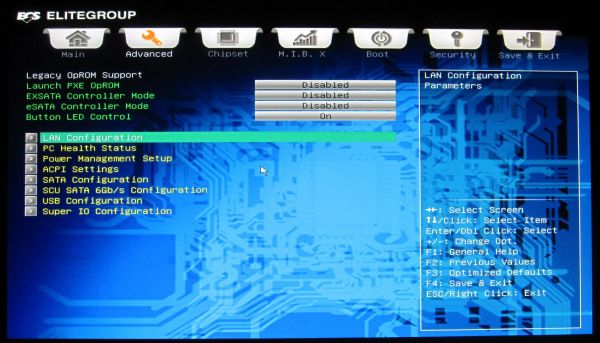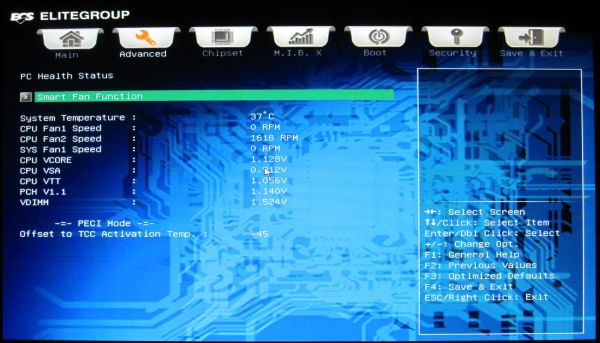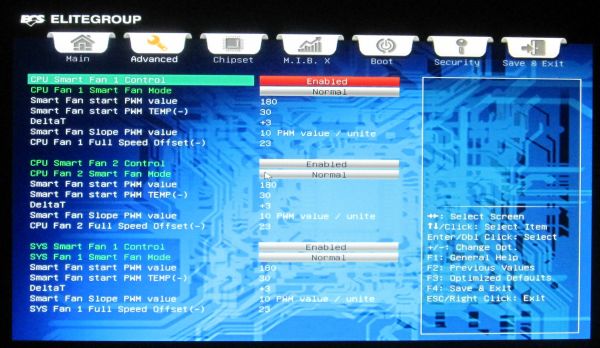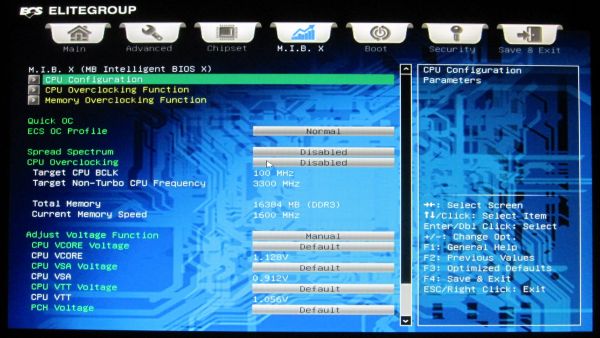ECS X79R-AX (Black Extreme) Review
by Ian Cutress on January 13, 2012 12:30 PM EST- Posted in
- Motherboards
- ECS
- X79
BIOS
There are a lot of manufacturers who put a substantial amount of time and effort into their BIOS systems, and it shows in terms of compatibility, performance, and presentation. In the early days of P67 UEFI, ECS' implementation wasn't much more than a glorified old-fashioned BIOS, with a new set of colors and menus. Back in my ECS HQ Tour in June, I walked past engineers working on their 'more graphical' implementation, which is what we have to look at today. Admittedly, from a usage standpoint, not much has changed - it still feels like you're navigating an old fashioned BIOS system, but with an enhanced color scheme.
One small change that ECS have done is with an easy and advanced mode for their BIOS. At the minute, the BIOS defaults to the Advanced mode, which defeats the purpose of an easy mode, however that may change with BIOS updates. The Easy menu has four buttons - Language, Default, Boot and Advanced, which essentially do what they say on the tin. The Boot menu allows you to select a one-off boot device, which is odd when this option isn't in the advanced part of the BIOS menus (and one I rather like).
The BIOS is easy to navigate, but the initial screen doesn't provide any of the vital information a user might need - CPU, current CPU speed, Memory installed, Memory speed, basic voltage readings, fan speeds, temperatures. This is all basic stuff which could be listed on the front page for quick access. In terms of temperature/fan speed/voltages, these are found in the PC Health submenu, which further expands into the smart fan settings.
The smart fan settings and controls have preset modes, or manual adjustments. This is the only place you can set the CPU fan settings - the OS software only allows control of the SYS fan headers. Personally, I prefer the OS software anyway to the OS controls here - units such as 'PWM value' have no place on a user screen on a BIOS.
The main bread and butter of a BIOS is in the overclocking, found under the M.I.B. X heading in the ECS BIOS. The front screen contains some of the overclocking tools - the very good 'Quick OC' option which puts the board into preset values supplied by ECS (more on that later), a set of ECS OC profiles (not so good, as of the BIOS I am using), BCLK and CPU strap adjustments, and voltage modification. This screen doesn't have anything CPU multiplier or memory related, which is a big oversight, as they are just as important.
Voltages are only available in offset mode, which is frustrating when the CPU VCore lists the current value, rather than the stock value. In order to change the BCLK, the 'CPU Overclocking' option needs to be set to enabled. In order to adjust the CPU multiplier, users have to navigate to the 'CPU Overclocking Function' menu. Memory tweaking requires the 'Memory Overclocking Function' menu. Note, as of the 12/26/2011 BIOS, I was unable to adjust the CPU multiplier. Another issue is when a user changes the CPU strap from 1.00x to 1.25x - this directly affects the memory, but as there isn't a memory setting on this M.I.B. X front screen, users may suffer boot failures due to memory being clocked too high.
Other points to be noted in the BIOS:
- By default, the bottom six SATA ports are set to disabled, as they are technically not supported by the chipset. Users have to navigate to Advanced -> SCU SATA to enable the ones listed 'SAS'.
- On the 12/26/2011 BIOS (which I'm told may not be a full release BIOS), the WiFi and Bluetooth were also disabled by default. ECS tell me that for consumers, these will be enabled by default, and thus installed by the Chipset driver utility program. Just a heads up if they still are not working after you have installed the chipset drivers.
- Overclock recovery is almost non-existent on the X79R-AX. Whenever I had overclock issues, especially memory, the board would stop on a POST code for a minute or two, then shut down. On trying to clear CMOS, I was left with a blank Debug LED and the board still not even getting to BIOS. The only way to remedy this was to remove the power cord, then hit the Clear CMOS button on the IO panel. The board would then boot, albeit with all my settings lost.
Overclocking
As mentioned a couple of times so far this review, the X79R-AX is a dichotomous motherboard for overclock with the BIOSes I had access to. There are several ways to overclock: by the 'Quick OC' option in the BIOS, by the 'ECS OC Profile' settings which split into memory and CPU, by the OC software in the OS, or by manual adjustment. I will go through each one in turn.
With Quick OC, I was asked to confirm I wanted to proceed, then the board did two hard resets before going into the OS. In the OS, the CPU idled at 1.2 GHz as normal, but in single and multi-threaded mode, this rose to 4.5 GHz (45x multiplier, 100 BCLK) at 1.416 V. The memory was also set to its first XMP profile, which with this set (which has two XMP profiles) gave DDR3-2133 8-10-10. This setting was completely Blender stable, never going above 73ºC.
Back in the BIOS, I now move on to the 'OC Profile' Settings, which is split into CPU and Memory, and each of these is split further. The CPU options split into light/medium/heavy, each with different effects to the BCLK:
- Light: 1.00x strap, 102 BCLK
- Medium: 1.25x strap, 101 BCLK
- Heavy: 1.25x strap, 103 BCLK
On the light setting, the board booted into the OS, however Turbo was disabled, limiting me to 33x multiplier and 102 BCLK, technically making the performance worse than stock settings. Neither the Medium or Heavy setting worked, in fact not even getting to POST. This is because I feel these settings do not take into account the DDR3 memory adjustment - putting an extra 25% through the memory at the same JEDEC sub-timings isn't always advised without due care and attention, to which the user receives no notification on the M.I.B X screen.
With the Memory OC Profile settings, we have options on my memory from 1600 MHz in straps going up to 2400 MHz. The 2133 setting on my memory worked, booting into the OS at 9-11-9 sub timings. However the 2400 MHz setting didn't, giving POST code 64 on the Debug LED, relating to memory.
In terms of the OS overclocking software, eOC, we haven't got much to play with here. The only adjustable is BCLK, which for all intents and purposes for most users is not very useful. There is also an option to adjust the voltages, but these values move with the different power states which the board is in, which could be an issue if a user sets 1.4 V while the board is in an idle state, causing more +mV when in a load state.
And finally, manual overclocking, which for this board, is almost non-existent. I had full reign over BCLK adjustments and CPU strap settings, getting 127 BCLK out of my processor. However, for CPU multiplier adjustments, I hit a brick wall. All the CPU multiplier adjustments are under the 'CPU Overclocking' menu in M.I.B. X, and to adjust the multiplier you have to turn the 'CPU Ratio Setting Control' from 'By Turbo Boost' to 'Manual'. This gave access to the Multiplier, but the board would not apply (or save) any value I changed this to. I tried adjusting the Turbo Boost per-core numbers as well, but this gave me nothing. If I booted with these settings off of default, the OS would reduce to 33x multiplier max, giving a worse-than-stock performance.
As a whole on the overclocking side, I was really pleased with the Quick OC result. Having 4.5 GHz at 1.4 V with XMP enabled is a great, one-button result. However, the other options leave a lot to be desired.




















36 Comments
View All Comments
connor4312 - Friday, January 13, 2012 - link
Good mobo, great price (relatively). Now if only the 3930k would come back in stock...Ratman6161 - Monday, January 16, 2012 - link
That may not be true if you want a 32 GB memory configuration. With 4 Dimm slots you need 8 GB modules where with the boards with 8 slots you can use cheaper 4 GB modules. Checked NE and saw 4x8 kits going for about $100 more than 8x4. If 16 GB is enough for you (and honestly, how many people really NEED more than 16 GB) then this won't matter. But if you want to go for 32 it may actually come out cheaper to buy a more expensive mother board with 8 slots.gw33dz - Friday, January 20, 2012 - link
That's a good point, on the other hand, if your going the way of 2011 then your going for performance, and i believe (correct me if i'm wrong) that 4 populated ram slots will perform better than 8, in quad channel. I've based this on the principals of dual channel, and I would actually appreciate confirmation either way if my assumption is correct. Those 8GB module kits are pricey at the moment, but another benefit (if you need the 32GB) will be lower power consumption and therefore less heat generation.It's interesting to note with this mobo the dual GB Network adapters, I really wonder why most other x79's are neglecting this feature.
flipmode - Friday, January 13, 2012 - link
There are some golden rules to follow once it comes to building your own computer. One of those golden rules is:Do *NOT* buy ECS.
ECS sucks. I don't care if they accidentally did an "OK" job this time. Surely their BIOS support will be a total disappointment just as it is already clear that they cut a bunch of corners on this board to begin with.
Do *NOT* buy ECS.
AssBall - Friday, January 13, 2012 - link
I dunno if you had some bad experiences or what, but I have done a few builds with ECS and thought the quality and reliability were pretty good. Also always an excellent value.I never tried one of their enthusiast boards though.
futurepastnow - Friday, January 13, 2012 - link
Years ago, ECS merged with another company, PC Chips, which many years earlier infamously sold 486 motherboards with fake caches and counterfeit chipsets.Some geeks never forget.
estover - Friday, January 13, 2012 - link
futurepastnow said:"Years ago, ECS merged with another company, PC Chips, which many years earlier infamously sold 486 motherboards with fake caches and counterfeit chipsets.
Some geeks never forget."
Yep I'm one of them. When I think of ECS, I think shit!
iamkyle - Saturday, January 14, 2012 - link
They're called 'Extreme Crap Systems' for a reason, you know.piroroadkill - Tuesday, January 17, 2012 - link
Yeah. PC Chips boards were absolute bottom of the rung, and so were ECS.I know about the fake cache chips on the boards too.
Wesleyrpg - Sunday, January 15, 2012 - link
i remember this, im fact im sure i switched boards from VLB to PCI, and still ended up with a board with fake cache (on both boards).Was around August 1995 if i remember correctly! (i was in uni at the time and didn't have alot of money for an expensive board)
Maybe i should send ECS an invoice for two motherboards...... :)